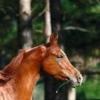assorted questions
Forums
I was explaining horse colors to a horse friend and came up with a few questions.
Is Silver a dilution? It actually acts just like agouti in that it restricts black, only more so than agouti.
When black is restricted red is left so why isn't red dominant?
Flaxen 'seems' to be a counter to Silver, in that it double restricts color from mane and tail and lightens the body, instead of on black it works on red.
Except sometimes a darker chestnut shows up with flaxen mane and tail, unless in those cases it is caused by something else?
Is there a theory about what causes different shades? eg light bay, dark bay. llighter/blond chestnut or red chestnut?
I know sooty can make a color appear darker but sooty is darker from the top down, (right?) some bays are uniformly light or dark, as are some chestnuts.



Is Silver a dilution? It
Yes, Silver is considered a dilution. It doesn't restrict black it lightens it. Agouti restricts black to the points. Silver lightens black wherever it may be it doesn't alter it's location.
Flaxen doesn't lighten the body only the mane and tail. It can be present in any color chestnut including liver. I think you may be thinking of Panagre which does lighten the body and is sometimes present with flaxen (but they are often found separately as well).
A very dark liver chestnut with flaxen
In cats these genes are referred to as "Rufus Modifiers" and they are said the control the shade of an animal. The truth is that we don't really know how many genes control shade but it is inheritable at least to some extent.
Some of horses that were in the past called sooty are now know to be brown. Brown does affect a horse from the top down. True sooty tends to be more evenly dispersed. or affect the lower part of the body more.
Hope that helps some
Sooty Palomino
A very interesting chestnut with flaxen, sooty, and pangare